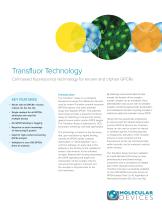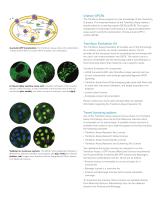
Catalog excerpts

Transfluor TechnologyCell-based fluorescence technology for known and orphan GPCRs KEY FEATURES • Works with all GPCRs—known, orphan, Gi, Gs, Go, Gq • Single readout for all GPCRs eliminates the need for multiple assays • No GPCR labeling or tagging • Requires no prior knowledge of interacting G-protein • Ideal for high-content screening (HCS) analysis • Validated in over 100 GPCRs (from all classes) Introduction The Transfluor® Assay is a cell-based fluorescence assay from Molecular Devices used to screen G-protein-coupled receptors (GPCRs), ligands, and other potential drugs that regulate GPCRs. This patented technology provides a powerful functional assay for detecting a compound’s activity against known and/or orphan GPCR targets. The Transfluor Assay is optimized for HCS, secondary screening, and lead optimization. The technology is based on the discovery that, upon activation by ligand binding, virtually all GPCRs rapidly undergo deactivation or “desensitization” by a common pathway. An early step in this pathway is the binding of the cytoplasmic protein, beta-arrestin, to the activated receptor. Beta-arrestin binding deactivates the GPCR signalling and begins the translocation of the receptor into the cell where the ligand is removed and the receptor is recycled back to the cell membrane. By attaching a fluorescent label to beta-arrestin, the location of the receptor-arrestin complex can be monitored. Since desensitization only occurs with an activated receptor, monitoring beta-arrestin translocation and subsequent receptor recycling provides a method to detect the activation of any GPCR. Using cell lines genetically engineered to express both the labeled beta-arrestin and the GPCR of interest, the Transfluor Assay can be used to screen for natural or synthetic ligands, including agonists or antagonists. Activation of the receptor induces a mass movement of the fluorescence to the cell membrane (pits) within seconds, and to endocytic vesicles within minutes. The Transfluor Assay has been validated as a gold-standard HCS assay by many pharmaceutical and biotechnology companies, and is considered an integral part of their drug discovery process. Transfluor has been successfully validated on over 100 GPCRs and works across all GPCR classes (Class I, II, III), regardless of interacting G-protein (Gs, Gi/o, and Gq).
Open the catalog to page 1
Orphan GPCRs rapid recycling desensitization internalization 4a vesicles slow recycling The Transfluor Assay requires no prior knowledge of the interacting G-protein. This important feature of the Transfluor Assay makes it ideally suited for screening orphan GPCRs (oGPCR). The Ligand Independent Translocation (LITe) assay is an agonist-independent assay used to verify the translocation of beta-arrestin-GFP in orphan GPCRs. ß-arrestin-GFP translocation. The Transfluor Assay utilizes the redistribution of beta-arrestin-GFP to monitor GPCR activation and inactivation. Transfluor Evaluation Kit...
Open the catalog to page 2
Please contact your local sales representative for detailed information regarding these licenses. In conjunction with the Transfluor Assay license, Molecular Devices also offers a stably transfected GFP beta-arrestin starter cell line and relevant plasmids. Purchase of these Transfluor Assay products requires a prior execution of the Transfluor Assay License Agreement and the BioImage license. If ordering the GFP cell line or plasmid, a Prolume license is also required for purchase. Email: info@moldev.com Check our website for a current listing of worldwide distributors. MOLECULAR...
Open the catalog to page 3All Molecular Devices catalogs and technical brochures
-
EMax Plus Microplate Reader
4 Pages
-
ImageXpress Pico
8 Pages
-
Threshold Immunoassay System
4 Pages
-
GenePix 4000B Microarray
2 Pages
-
SpectraMax iD5
8 Pages
-
CloneMatrix
2 Pages
Archived catalogs
-
MetaMorph NX
4 Pages
-
MetaFluor Software Brochure
6 Pages
-
MetaXpress
6 Pages
-
EMax Plus Microplate Reader
3 Pages
-
FlexStation 3
6 Pages
-
SpectraMax MiniMax 300
3 Pages
-
SpectraMax M series
6 Pages
-
SpectraMax Paradigm
6 Pages
-
SpectraMax i3x
6 Pages
-
CloneMatrix - Data Sheet
1 Pages




























